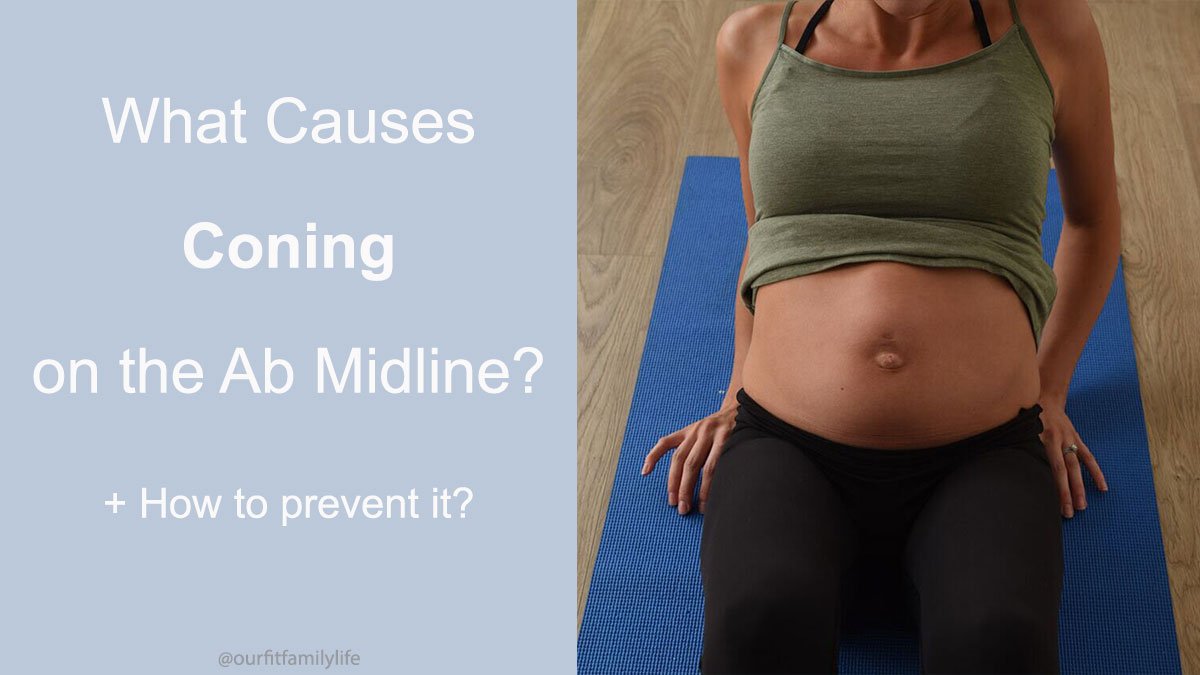Coning on the abdominal midline is a common occurrence for postpartum women. While it may look alarming, coning is simply a visual sign that your core isn’t effectively managing intra-abdominal pressure. It’s important to avoid coning as much as possible, though.
Learning how to address it can help you avoid exacerbating any existing core dysfunction, such as Diastasis Recti, pelvic floor dysfunctions, or back pain.
What is Coning?
Coning refers to the protrusion or bulging of the abdominal midline during exercise or certain movements, such as sitting up from bed.
It often appears as a ridge running vertically along the center of your belly.
This phenomenon occurs because the connective tissue along the linea alba, which runs from the sternum to the pubic bone, is not effectively supporting the pressure created within your abdominal cavity during exertion.
This can happen with or without having a Diastasis Recti!
Why Does Coning Happen?
Several factors can contribute to coning:
-
Incorrect breathing strategies when you exercise can lead to increased pressure on the abdominal wall.
Holding your breath or bearing down during exertion can push pressure downward and outward - causing the midline to bulge.
-
If your core muscles aren’t properly engaged, they cannot work together to create tension along the ab midline effectively.
This includes how your deep abs, pelvic floor, and diaphragm work together.
-
Using poor form can lead to coning.
For example, front planks or push-ups performed without proper alignment can put undue stress on the abdominal wall.
-
Conditions like Diastasis Recti weaken the connective tissue between your abs (the linea alba), making it less resistant to pressure.
This can cause the midline to protrude during certain movements.
-
Even if you're engaging your core correctly and using proper form, coning can still occur when the demands of an exercise exceed your current core strength and capacity.
How to Correct Coning?
How to fix coning • Step 1:
Start by rehabilitating your core with exercises prioritizing core breathing, proper alignment, and gradual strengthening.
These foundational movements are crucial for restoring the linea alba’s integrity and improving your core’s stability. With consistent practice and attention to form, you’ll retrain your core to manage pressure and work optimally.
How to fix coning • Step 2:
After completing your core rehab, coning might still occur! If it happens, it’s usually a sign that the exercise is too challenging for your core at the moment.
Try lightening the load or modifying the movement to match what your core can handle while maintaining proper form.
From there, focus on progressive overload techniques to slowly and safely build your core’s strength and capacity over time.
Is Coning Dangerous?
Coning is not inherently dangerous, BUT it indicates that your core is struggling to stabilize or engage properly during certain movements.
Repetitive coning can lead to the following:
Worsening of Diastasis Recti
Increased pressure on the pelvic floor muscles - potentially causing issues like leaking or pelvic organ prolapse
Straining the back muscles - leading to discomfort or injury
Addressing coning can help you avoid these complications and move toward a stronger, more functional core.
Common Misconceptions About Coning
1.“Coning means I’m failing.”
Coning is not a failure; it’s simply feedback from your body. Use it as an opportunity to refine your approach and build strength progressively.
2.“I should avoid all core exercises.”
Avoiding core work altogether is not the solution. Instead, focus on core breathing exercises that promote proper engagement and alignment. Strengthening your core with the right exercises is essential for long-term healing.
3.“Coning only happens to someone with a Diastasis Recti.”
While coning is commonly linked to Diastasis Recti, it can also occur in anyone with a weak core, improper breathing techniques, or poor exercise mechanics.
Takeaway
Coning on the abdominal midline indicates that your core is not yet fully connected or capable of managing intra-abdominal pressure during certain movements.
While it may be frustrating to experience, it’s an opportunity to refine your form, improve your breathing strategy, and rebuild your core strength from the inside out.
If you’re unsure about how to proceed or need additional support, don’t hesitate to reach out to me, or restrengthen your core with the Better Body after Baby Program.
Online Programs:
Immediate Postpartum Program - From Birth to 8 Weeks PP
Better Body after Baby Program - Pelvic Floor & Core Rehab



